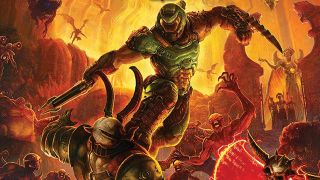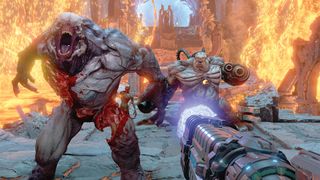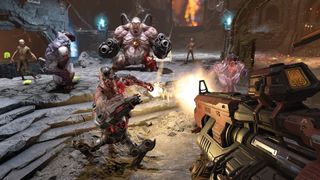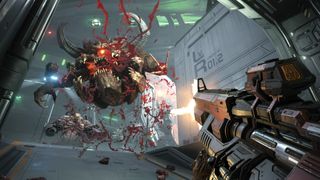In Doom Eternal the Doom Slayer is faster, stronger, and more brutal than ever
Doom Eternal almost makes Doom 2016 look boring.

I'm in space, above Mars, so close that the hulking red planet fills the entire screen. A massive chunk has been torn out of it and I'm hopping between shards of rocky debris that have broken loose, slaughtering demons with a super shotgun.
Doom Eternal, a sequel to 2016's stellar reboot, is a game of impossible scale and drama. So much so that the previous game seems almost boring in comparison.
"From the beginning our goal was making you fight in unbelievable locations, surprising you every step of the way,” says id Software’s Marty Stratton, producer of Doom Eternal. “From the very start to the final boss, players will be seeing things they’d never expect from a Doom game.” “It’s all about engagement,” says creative director Hugo Martin, a word the two developers use several times in our interview. “Not only do these moments achieve that from a visual perspective,” he adds, “but the mechanics contribute to it too.”
The Doom Slayer can now climb, grabbing hold of surfaces with a certain texture, which opens up the level design massively. He can dash in mid-air as well, crossing wide gaps and leaping up to climbable surfaces. “These new abilities are interwoven with our visual set-pieces, so it’s not just for show,” says Martin. “You have to think your way through the level design in Doom Eternal.”
I get a taste of this when, to make my way across this mess of floating space-rocks, I have to air-dash between them, grabbing hold of them at the last minute, otherwise I’ll fall into the void below.
Like the series’ gunplay, these new movement controls feel slick and responsive. But occasionally I have to remind myself that I’m playing a Doom game. I ask the developers how, with all this wild new stuff going on, they’re staying true to the distinctive feel of the series.
“As long as the solution to every problem involves the player being aggressive somehow, it feels like Doom,” says Martin. “Every action the player takes is an aggressive one, whether it’s jamming your hands into a rock face and climbing like a bear, breaking chains apart, or smashing through a wall. All of this feeds into the idea of being the Doom Slayer, reinforcing his role in the world.”
The biggest gaming news, reviews and hardware deals
Keep up to date with the most important stories and the best deals, as picked by the PC Gamer team.
Another thing I notice in my demo is how the flow of the level feels much more organic than anything in the 2016 game. “As fun as the last Doom was, there was a monotony to it,” admits Marty Stratton. “In the later levels especially it felt like corridor, arena, corridor, arena. There’s a grandeur to the combat arenas, or combat stadiums as Hugo likes to call them, in Doom Eternal. But the in-between spaces, the glue of the level, aren’t just about getting you from one place to the next. We want you to engage with these more this time.

“There’s a lot of exploration and secrets, which are of course a big part of any Doom game. We want players to use their minds. There are some fun, simple, but engaging puzzles in there too. Puzzles with a small P. Combat puzzles, really. We really want the moments between the fighting to be interesting.”
I admit that I found the previous Doom a little repetitive, but playing Eternal, I’m struck by how varied it is. Between the different guns, each with their own alternate fire modes, a new crop of demons, all of whom behave differently, and a range of new abilities, there’s tons to think about in every firefight. If you need health, perform a glory kill on an injured enemy—a brutal, gory instant takedown. Need armour? Roast an enemy with your new shoulder- mounted flamethrower and they'll spit it out. It's some of the most exciting, dynamic first-person combat I've ever played.
“You were empowered to make those decisions,” says Marty Stratton. “If you’re low on health you know you have a tool to get some. There aren’t 15 ways to get health. You can find it in the world as usual, but really it’s about glory killing enemies.
“Or if you need armour, you can use the flame belch. We’re not hiding this stuff. You aren’t at the whim of a level designer, it’s in your hands.”
“We want to keep you thinking. That’s the key ingredient to engagement,” says Hugo Martin, using that word again. “A game that gives you something to master is a game that’s worth playing.”
One battle in particular, towards the end of the demo, felt like spinning plates. I had to constantly think about which enemies to deal with first, never stopping for a breath, using jump pads and cover to my advantage. It was relentless and exhilarating, and difficult too. But the satisfaction of getting slightly better with each botched attempt, and eventually beating it, was immense.
Deadly enemies

The new demons, some of whom return from Doom 2, are a big part of what makes the combat so interesting. I ask the two developers which of the new bestiary they enjoy fighting the most. “I like the Carcass a lot,” says Martin, referring to a three-legged demon that can throw up energy shields. “It can block you from glory killing and protects other AI. There’s a lot going on in Doom Eternal. It’s very tightly balanced. The rocket launcher is more powerful, but the rockets move more slowly, they do more self damage, and there’s less ammo.
“So a missed rocket hurts more, and it can blow up in your face, which makes the Carcass’s shields so tricky. When you face them you really have to think about using that rocket launcher.”
“I like the Mancubus,” says Stratton. “He’s not new, but he’s been updated. He and a lot of the other heavies have these weak spots. For example, you can shoot the Mancubus’ guns off its arms. It’s so satisfying to hear the metallic plink sound of them being destroyed. You can really weaken enemies this way, and you’ll have to because they’re how deep the combat is, and how many layers there are to peel back. “Doom is fun, it’s a power fantasy, it’s rock and roll, all of those things,” says Martin. “But we wanna make a smart game too, where every decision has meaning, with scope for mastery. As you play you’ll learn and get better. Every time you die we want you to feel like you’ve learned something. You know the game didn’t screw you, it was you who messed up, and you wanna get back in and take another shot at it. That’s a really hard thing to get right, but I feel like we’ve hit the sweet spot in Eternal.”
There are double the number of demons in Eternal, but Stratton is keen to stress that this isn’t just because it looks cool in a features list—it’s an attempt to make the game more, yes, engaging.
“We’re challenging players all the way through the game, with the scope of the levels, the level design,” he says. “We’re constantly throwing new enemies at you all the way into the late stages. Honestly, you’d hit a plateau in the 2016 game. You’d get to an arena, see the same targets, and handle them easily. But that won’t happen here. You need to restructure your priority list several times during a fight and also decide which weapons and mods to use. Overall, whether it’s the demons or the level design, we never want you to hit that brick wall.”
Rip and tear

One of the quirks of the previous game is that, despite being an all-out action game, it also had a surprising amount of story to snack on. Eternal will be the same, but players who want to flesh things out will have to actively decide to do so. “The story is all about increasing your level of engagement and adding a bit of context to the experience,” says Stratton. “Through the plot, environmental storytelling, world building, we want to give everything you do meaning.
“But we want to keep it lean and mean. We tend to focus on the A-story, which is where you’re going and what you’re doing. The general high level idea of why you’re doing this stuff has to be clear to you, and that’s on the main path.”
More importantly for id Software, in terms of story, the Doom Slayer has to feel like the Doom Slayer. “The trick is making it feel like the character in the story behaves the same way as the character you’re playing as,” says Stratton. “When you play Eternal you’re a vicious killing machine that everyone is terrified of, and in the story that’s exactly who you are as well.”
As for the tech powering Doom Eternal, this is the first game to use the newest version of id’s in-house engine, id Tech 7. “The rendering engine hasn’t been rebuilt, but refactored quite a bit to allow for many, many, many more polygons on the screen,” says Stratton. “That’s one of the biggest improvements, because it allows us to make even bigger worlds. Levels are two or three times the scope of anything in the 2016 game, which is a direct result of using id Tech 7. It also makes the game more destructible. Whether that’s the enemies or the levels. You’ll see moments and set-pieces of destruction on a massive, epic scale, which feeds back into the aggression of Doom. This is a whole new tech system we developed. We’re very confident calling this id Tech 7 over the last game, which used id Tech 6. It’s an evolution in every way.”
The previous Doom is one of the best reboots of all time, but it didn’t quite offer enough variety. So that’s why I’m excited about Doom Eternal, because it’s the same kind of vicious, fast, thrilling combat, but with a lot more going on under the hood. By making the Doom Slayer more mobile, greatly expanding his arsenal, and giving him double the number of demons to massacre, Eternal is shaping up to be one of the best entries in the Doom series to date. If they can keep the quality of my demo up for the length of the whole game, you’re in for a hell of a treat.
If it’s set in space, Andy will probably write about it. He loves sci-fi, adventure games, taking screenshots, Twin Peaks, weird sims, Alien: Isolation, and anything with a good story.
Most Popular

